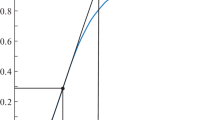Abstract
Currently, there is a growing demand for automatic control systems for unmanned aerial vehicles due to the numerous civil and military applications. An unmanned aerial vehicle has sophisticated and complex controllers that are used to stabilize it, which composes the autopilot. In autopilots, PID controllers are commonly used, and various techniques are applied to tune their gains. In this paper are proposed optimization procedures of gains for the designed PID controllers from the transfer functions simulated in the Matlab/Simulink software, establishing a model-in-the-loop system, for the autopilot of the Cessna 182 aircraft. In this context, results of simulations are obtained to prove the effectiveness of using these proposals for optimization. They offer a simple, effective, systematic and replicable way to obtain the gains and dispense the use of classical methods of determination of gains for control loops, as well as the trial and error method.









Similar content being viewed by others
References
Blakelock, J. H. (1991). Automatic control of aircraft and missiles. New York: Wiley.
Cook, M. V. (2007). Flight dynamics principles. A linear systems approach to aircraft stability and control (2nd ed.). Oxford: Butterworth-Heinemann.
do Carmo, M. J., Oliveira, Â. R., & Carvalho, J. R. (2012). Use of statistics as non-intrusive indexes in the evaluation of behavior of the control loops: A case study for systems with transport delay. In XXXVI national congress of applied and computational mathematics (CNMAC) (vol. 2194, pp. 1034–1040). (in Portuguese).
Franklin, G. F., Powell, J. D., & Emami-Naeini, A. (2015). Feedback control of dynamic systems (7th edition, Global Edition). New York: Pearson.
Kada, B., & Ghazzawi, Y. (2011). Robust pid controller design for an UAV flight control system. Lecture Notes in Engineering and Computer Science, 2194, 945–950.
Lehmann, E. L., & Casella, G. (2006). Theory of point estimation. Berlin: Springer.
Mathworks.com: Simulink design optimization (2016). http://www.mathworks.com/help/sldo/index.html.
McLean, D. (1991). Automatic flight control systems. Englewood Cliffs, NJ: Prentice Hall.
Nelson, R. C. (1998). Flight stability and automatic control. New York: WCB/McGraw Hill.
Ogata, K. (2011). Modern control engineering (5th ed.). New York: Pearson.
Pedroni, J. P., Cova, J. D. W. (2013). Orientation control with velocity feedback loop for an aerospatial gimbal nozzle implemented in a hardware-in-the-loop simulation environment. IEEE Latin America Transactions, 11(11), 287–292. https://doi.org/10.1109/TLA.2013.6502818.
Research, L. (2016). X-plane. http://www.x-plane.com.
Ribeiro, L. R., & Oliveira, N. M. F. (2010). Uav autopilot controllers test platform using matlab/simulink and x-plane. In Proceedings of the 40th ASEE/IEEE frontiers in education conference (pp. 1–6). Washington, DC. https://doi.org/10.1109/FIE.2010.5673378.
Rodrigues, L. E. M. J. (2013). Fundamentals of aeronautical engineering. Cengage Learning. (in Portuguese).
Roskam, D. (2001). Airplane flight dynamics and automatic flight controls—Part I and II. Lawrence: DAR Corporation.
Santos, S. R. B., & de Oliveira, N. M. F. (2011). Longitudinal autopilot controllers test platform hardware in the loop. In Proceedings of the 2011 IEEE international systems conference (SysCon) (pp. 379–386). Montreal. https://doi.org/10.1109/SYSCON.2011.5929071.
Splendor, F., Martins, N. A., Gimenes, I. M. S., & Martini, J. A. (2015). Design of an autopilot for cessna 182. IEEE Latin America Transactions, 13(1), 27–36. https://doi.org/10.1109/TLA.2015.7040624. (In Portuguese).
Thums, G. D., Torres, L. A. B., & Palhares, R. M. (2012). Methodology of pid tuning with multiloop for unmanned aerial vehicles: Longitudinal dynamics. In Proceedings of the XIX Brazilian congress of automatic (pp. 358–365). Campina Grande, PB, Brazil. (in Portuguese).
Vale, M. R. B. G. (2007). Comparative analysis of the performance of a controller coupled to a fuzzy neural pid tuned by a genetic algorithm with intelligent conventional controllers. Master’s thesis, Postgraduate Program in Electrical and Computer Engineering, Federal University of Rio Grande do Norte. (in Portuguese).
Acknowledgements
The authors are thankful to the Coordination for the Improvement of Higher Education Personnel—CAPES—for the financial support.
Author information
Authors and Affiliations
Corresponding author
Rights and permissions
About this article
Cite this article
Freire, F.P., Martins, N.A. & Splendor, F. A Simple Optimization Method for Tuning the Gains of PID Controllers for the Autopilot of Cessna 182 Aircraft Using Model-in-the-Loop Platform. J Control Autom Electr Syst 29, 441–450 (2018). https://doi.org/10.1007/s40313-018-0391-x
Received:
Revised:
Accepted:
Published:
Issue Date:
DOI: https://doi.org/10.1007/s40313-018-0391-x




